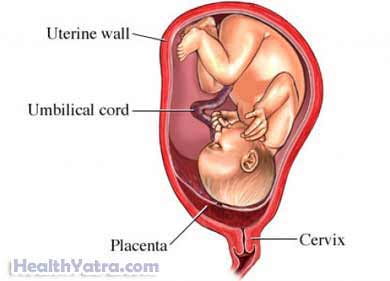Definition
The placenta is an organ that develops in the uterus during pregnancy. Its purpose is to nourish the baby. Oxygen and nutrients pass through the placenta to the baby. Waste products pass back out to the mother’s blood stream.
Placenta previa occurs when the placenta becomes implanted near or over the cervix. The cervix is the lower part of the uterus that opens into the vagina. With this condition, the placenta may cover part or all of the cervix. This condition is only diagnosed after 20 weeks of gestation.
Placenta previa can cause problems in pregnancy and birth. These include:
- Abnormal bleeding, sometimes heavy
- Premature separation of the placenta from the uterus
- Premature birth
- Emergency cesarean (c-section) delivery
- Problems with penetration of the placenta into the uterine muscle or through the entire uterine wall
Causes
Possible causes of placenta previa include:
- A scarred endometrium—the lining of the uterus
- A large placenta
- An abnormal uterus
- Abnormal formation of the placenta
Risk Factors
Factors that may increase your chance of developing placenta previa include:
- Previous cesarean section
- Uterine problems, such as fibroids
- Multiple pregnancy—two or more fetuses
- Multiple previous full-term pregnancies
- Increased age
- Smoking
Symptoms
Placenta previa symptoms vary depending on how much of the cervical opening is covered. The main symptom is painless bleeding from the vagina. This bleeding can range from light to very heavy. It usually occurs suddenly during late pregnancy. Spotting that occurs early in pregnancy may point to placenta previa, but in most cases the placenta safely moves away from the cervical opening before delivery.
Anything that disrupts the placenta, such as sexual intercourse or digital exam of the vagina and cervix, may cause bleeding.
Complications
Complications in a woman who is pregnant include major hemorrhage, shock, and death.
The risk of infection and blood clots or thromboembolism also increases, as does the likelihood of a blood transfusion.
Prematurity, which occurs when an infant is less than 36 weeks gestation, is responsible for about 60% of infant deaths from placenta previa.
Fetal blood loss or hemorrhage may occur from the placenta tearing away from the uterine wall during labor. It may also occur with entry into the uterus during a cesarean delivery.
Diagnosis
The doctor will ask about your symptoms and medical history. A physical exam will be done. A pelvic exam will not be done if placenta previa is a possibility. A pelvic exam may cause bleeding. Instead, an ultrasound will be done through the vagina or abdomen to view the placenta in the uterus. If placenta previa is detected early in pregnancy, with or without bleeding, another ultrasound will be done during the third trimester to be sure it has resolved.
Treatment
Treatment depends on several factors, including the amount of bleeding.
If placenta previa is diagnosed through an ultrasound but you have no bleeding, you do not need any treatment besides having the condition checked regularly. Your doctor may suggest that you take extra iron and folate in case you do have bleeding.
If only minor bleeding occurs and your pregnancy is 36 weeks or less, you may need to go on bed rest. If the bleeding stops, you may be allowed to get out of bed. However, you still need to be careful due to the risk of sudden bleeding. You should avoid intercourse and orgasm because they may start contractions and cause trauma to your cervix.
If the bleeding is heavy or your pregnancy is 37 weeks or more, the baby is delivered. You will most likely need a cesarean section.
Prevention
There are no guidelines for preventing placenta previa. However, if you have it, you need to do the following to prevent bleeding:
- Have the condition checked regularly.
- Carefully follow any instructions you are given regarding bed rest and what to do if you have bleeding or contractions.

